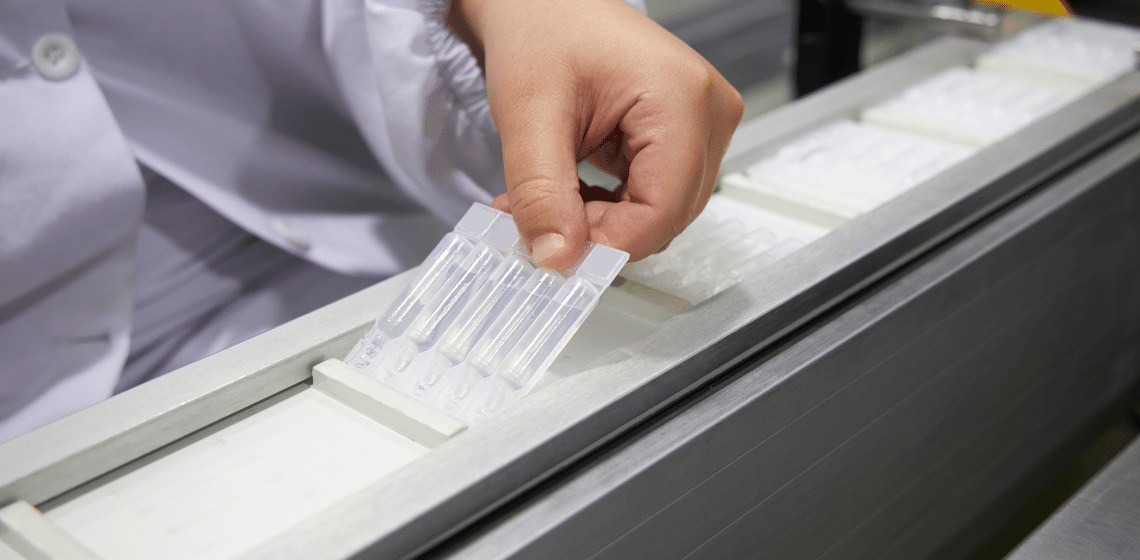How IoT Disrupts Manufacturing in Pharma

The right drug or treatment, for the right patient, at the right time. It’s the promise that precision medicine, wearables, and ingestible sensors are expected to deliver on. In this blog series, I’ll explore the possibilities of IoT in pharma. It is one of the most promising, and at the same time most ready-to-use technological possibilities that can optimize the end-to-end chain in the pharmaceutical industry.
As we saw in my previous blog, there are some big changes in pharma ahead, and I am keen to explore how technology such as IoT can help. In this second part of the blog series, I will argue how IoT can speed up the drug discovery stage and clinical stages of drug manufacturing. I will also dive into an upcoming trend in pharma: the shift from mass manufacturing to make-to-order. Which is intrinsically linked with the trend of precision medicine.
The Next Step for IoT in Pharma
In the first blog of this series, I discussed how IoT sensors make the process of setting a diagnose less intrusive for patients and save time and resources for hospitals. Now, let’s turn this idea around. IoT sensors on the one hand help patients and doctors, but they can also deliver on the promise of precision medicine for the Life Sciences industry, and more precisely be of use in the manufacturing process. Wearables and ingestibles generate a continuous stream of patient data. Traditional medicine focuses on a standard patient profile. Whereas precision medicine is tailored to a specific set of data from an individual. And that set of data? You guessed it: That data needs to come from the patient itself. Something wearables and ingestibles can provide.
Embracing the Make-To-Order-Model
In the near future, accelerated by the global customer-centric trend other manufacturers have been facing as well, pharma will be moving away from a ‘push model’ in which they manufacture bulky batches of medicine and ship those out to pharmacists based on demand forecasts. Instead, to deliver on the precision medicine promise, they will need to embrace the make-to-order-model. Going from volume-based generic medicine to cure-as-a-service, also means that the pharmaceutic industry needs to be in close contact with patients. Closer than ever before. In case of cancer or auto-immune treatments, for example, the patient’s own tissue, like stem cells, is used to manufacture a medicine. Even more reason to start moving towards a new human-centered model. Enter IoT again, which is crucial in this process.
IoT sensors can help to make the process of setting a diagnose less intrusive for patients and save time and resources for hospitals.
More Precise and Personalized Medicine
A customer-centric manufacturing model with IoT works the same way as when you use it to optimize the diagnosis process. An IoT sensor can monitor effects of a drug or treatment using real-time data from a patient’s body very accurately and send it to their specialist, GP, and in case of the cancer treatment example: the drug manufacturer. This way, pharmaceutical companies can tailor the dosage, type of drug substance, or other ingredients to deliver a personalized treatment and adapt when a treatment is not working properly. As a manufacturer you do need to keep in mind that if you choose to work on a cure-as-a-service basis, you need to adjust your facilities and production process to a modular model in which you can produce on a batch-of-one basis and easily switch your lines between batches.
Improving Products for Multiple Patients
Another benefit of biometric sensing with IoT in precision medicine manufacturing is the possibility of a continuous feedback loop. With this stream of data, specialists can monitor the effectiveness of a treatment. And, to take it one step further: if researchers pair this data with an algorithm, they will be able to improve the treatment over time. They can also use the outcomes of this research to improve the recipe formulation for other patients with the same characteristics, or even individualized groups.
Pharma will be moving away from a ‘push model’ and needs to embrace the make-to-order-model.
Raising the Bar in Discovery Stages and Clinical Trials
Besides providing an objective foundation for precision medicine, IoT can also make discovery stages and clinical trials more efficient. Innovative technology such as machine learning is already turning clinical trials into a more and more scientific process. In those, researchers utilize data coming from unbiased devices like sensors to tell the actual impact of a medicine, instead of only reporting side effects via patient questionnaires. On top of providing more objective data, IoT helps researchers in the discovery stages and clinical trials to collect data from larger – and even more diverse – groups of patients. These extensive datasets allow them to draw more precise conclusions about the general functioning of the product. IoT also lets researchers perform remote clinical trials, so patients don’t need to stay in clinical observation for a couple of days and can get on with their lives while data is being collected.
To close the loop: the right treatment, for the right patient, at the right time? It is within reach. And, as we have seen in this blog series, IoT is one of the keys to unlock this promise. With more and more people voicing their need for individualized treatments, more human-centered health care experiences, and society’s need for more objective and hard data in drug discovery and manufacturing, I think, it will only be a matter of time.
Your Next Steps in IoT and Pharma
Of course, when it comes down to optimizing processes, we are more than excited to help you. We can provide the data infrastructure (GxP datalake) to collect (privacy-)sensitive sensor information, connect the IoT devices via safe protocols to this data infrastructure and develop the algorithms for patient monitoring, applications for recipe selection, and any type of dashboard on top.
So, how can we help you to become ready for the future of precision medicine? Let’s talk!